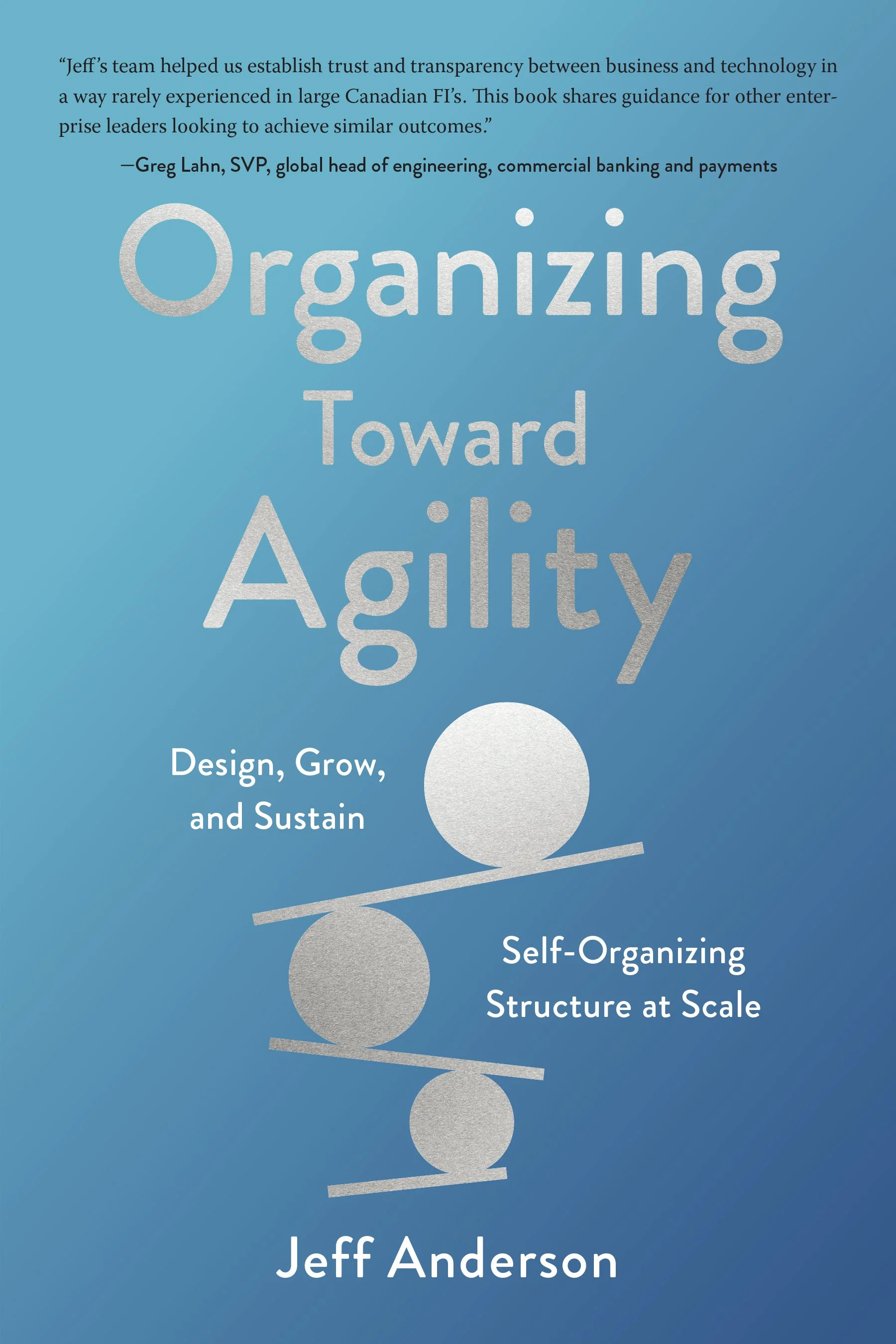Organizing Toward Agility
Buy the Book
Product Details
Publisher: Agile By Design Publications
Release Date: November 3, 2022
Formats: Paperback, Ebook
ISBN: PB: 978-1-7780930-0-5; EB: 978-1-7780930-1-2
Trim: 6 x 9
Page Count: 268
Design, Grow, and Sustain Self-Organizing Structure at Scale
Jeff Anderson
The way we think about organizations is wrong. Completely wrong.
The traditional business—one made up of departments, steered by management, and operated based on a fixed playbook—is based on concepts that are more than a hundred years old. As a result, most companies are built to meet the needs of the industrial age, not our current age of uncertainty.
But it doesn’t have to be this way. Organizing Toward Agility offers a new path forward: a team-centric, iterative approach to delivering value using customer feedback and continuous experimentation. This book will help you set up and operate new organizing structures, whether you want to make a larger organizational change or move your business forward incrementally.
With his practical tools and real-world examples, agile expert Jeff Anderson builds on decades of experience in enterprise-scale business transformation to help you shift the way you work. A must-read handbook for change agents of all types, Organizing Toward Agility will teach you how to design, grow, and operate organizations that can thrive in today’s complex world.
About the Author
Jeff Anderson is the president of Agile By Design, a global services firm that helps companies achieve business agility at scale through a thoughtful, design-driven approach to organizational evolution. Over the past decade, Anderson has led many enterprise-scale agile transformations.
Anderson frequently blogs about and presents on lean and agile adoption, and he is the author of “The Lean Change Method,” which guides organizational change through the application of lean startup techniques. His mission in life is to help knowledge workers be awesome at what they do.
Reviews
“Agility at scale is such an important competitive advantage in today’s digital world. Jeff does an amazing job laying out the blueprint for an agile organization, while also really shining a light on the human element. A must-read for all leaders driving digital transformation in their organizations!” —Brent Reynolds, president at Payson Solutions and former chief customer experience officer at Capital One
“The roots of consistent organizational decentralization and self-organization reach back a hundred years. Nevertheless, most of us have not yet fully wrapped our heads around these progressive ideas, and around their significance, in an age of complexity. Too few teams and organizations have embraced these concepts fully. Which is why I am delighted to see how cleverly Jeff Anderson has framed and articulated these concepts in his book. I wish this book a large readership and an equally large followership!” —Niels Pflaeging, BetaCodex Network founder
“The guide skillfully challenges traditional models of an organizational configuration and makes a solid case for reframing basic elements of a corporate structure. . . . a convincing argument for shifting to a team-based workplace.” —Kirkus Reviews
“The key competitive advantage of humans is our ability to work together for our mutual benefit. Traditional management strategies stole that advantage from us, and with this book, Jeff Anderson is giving it back to us.” —Scott Ambler, consulting methodologist, Ambysoft Inc.
“There are a lot of good books on value creation structures. Organizing Toward Agility has its own place in the crowd. The value of this book is that it provides a collection of practices that you can use to solve every day common problems. As you read more and use it more you get the deeper theory on which it is based by understanding its pieces. It doesn’t get into any agile wars but provides very useful advice that is sorely needed in the industry.” —Al Shalloway, founder and CEO of Success Engineering
“With this book Jeff’s done a tremendous contribution to the industry. The best part is the subtle way he employs patterns and pattern theory to derive pragmatic and actionable ideas. A must read for anyone who cares about being agile!” —Steve Tendon, author of Tame Your Work Flow
“Jeff’s team helped us establish trust and transparency between business and technology in a way rarely experienced in large Canadian FI’s. This book shares guidance for other enterprise leaders looking to achieve similar outcomes.” —Greg Lahn, SVP, global head of engineering, commercial banking and payments
“How we organize our teams matters, especially at scale. With this practical book, Anderson helps put the ‘organize’ back into the organization.” —Troy Magennis, president, Focused Objective
“What got you here won’t get you there. In today’s VUCA [volatility, uncertainty, complexity, and ambiguity] world, bureaucracy and command-and-control management are a liability. This book helps organizations move on from the impediments of scientific management to the adaptability of business agility, of what I call open work. Jeff Anderson understands the space completely, laying out a path forward that is itself agile, as it should be, experimenting and exploring a way forward to open, autonomous teams of empowered people getting the job done. The book is rich with anecdotes and examples. It gives us new thinking tools and metaphors for open work, such as the blade and the handle, the precision and control of work. This is a substantial body of work that merits study to understand the whole picture of agile ways of working in a large enterprise.” —Rob England, Teal Unicorn
“Jeff Anderson’s book Organizing Toward Agility provides countless examples and methods to enable people ‘to team’ with each other as they are solving the challenges they face in their organizations. Instead of encouraging the design of static organizational structures resulting in complicated handoffs and dependency tracking, Jeff illustrates the ways in which you can reteam to tackle your challenges head-on. There are also a variety of interesting connections made in his work with key industry ideas including domain-driven design, Kanban, team topologies, dynamic reteaming, and more.” —Heidi Helfland, author of Dynamic Reteaming

